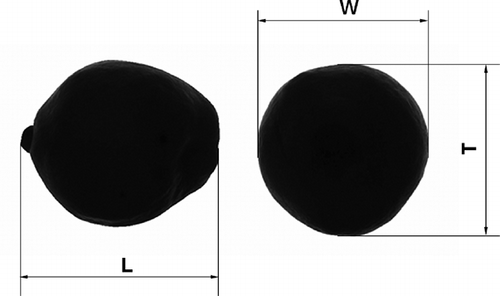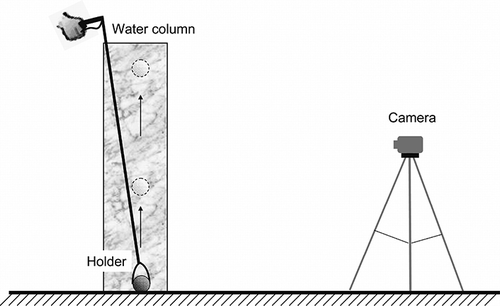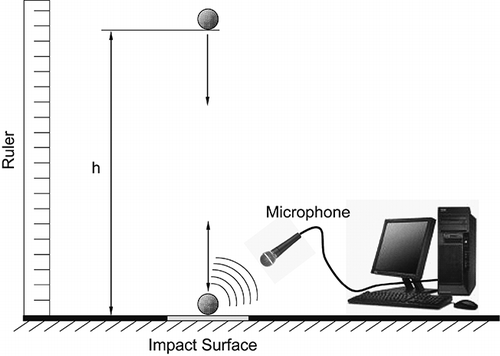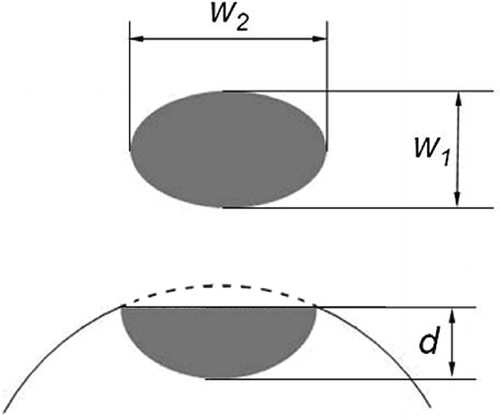Abstract
In this study, selected geometric properties, including linear dimensions; sphericity; mass of fruit; projected area; surface area; true density; volume; static coefficient of friction against different materials; hydrodynamic properties in water, such as terminal velocity, drag force, and buoyant force; and impact parameters, such as coefficient of restitution, absorbed energy, bruise area, and bruise volume, of two varieties of quince fruit were determined. The selected geometric and hydrodynamic properties were found to be considerably similar with both varieties in quince. The smallest values of bruise area and bruise volume were obtained with the corrugated board. The coefficient of restitution decreased with the increase in the drop height for each variety.
INTRODUCTION
Quince is the fruit of a deciduous tree of the Rosaceae family. Most varieties of quince are too hard, astringent, and sour to eat raw. They are used to make jam, marmalade, and jelly, as well as quince pudding. The quince has a long history of cultivation in the Middle East where it is native, and throughout the Mediterranean region. Greeks and Romans grew the quince for its fragrant fruit and attractive pink flowers. Nowadays, Turkey is the leading country of quince in the world.[Citation1] According to the mean of the last 10 years, quince fruit is grown on 10,000 ha areas in Turkey with a production rate of 99,148 t.[Citation2]
The main reason for the decreasing market values and quality of agricultural products is damage occurring between the point of harvesting and consumption. Fruits are susceptible to bruising when they impact each other or a hard surface during picking, packing, transportation, and retailing at stores and during other handling steps. Most research on the mechanical properties and bruising of fruit has focused on apples,[Citation3–7] pears,[Citation8–10] and peaches.[Citation11–13] The quinces have to be treated carefully to maintain quality and avoid losses due to damage. The major contributing factor to such losses is bruising. This is defined as damage, and discolouration of fruit flesh, such as apple, pear, and quince, usually with no breach of the skin. Research on the damage susceptibility of apples requires the determination of the bruise size. The measurement of bruise volume is difficult and time consuming to achieve accurate data.[Citation14]
Determining a relationship between mass, dimensions, and projected areas is useful and applicable in weight sizing. Hydrodynamic properties are very important characters in hydraulic transport and handling as well as hydraulic sorting of agricultural products. The fruit sorting is to use the terminal velocity of fruit moving in a fluid that has a density above or below the fruit density. Fruit with different terminal velocities will reach different depths after flowing a fixed distance in a flume and may be separated by suitably placed dividers.[Citation15] The objective of this study was to determine selected geometric and hydrodynamic properties in water, such as terminal velocity, drag force, and buoyant force, of quince fruit. In addition, the effects of varieties, drop heights, and selected impact surfaces on coefficient of restitution, absorbed energy, bruise area, and bruise volume were investigated. The selected geometric properties examined were linear dimensions, sphericity, mass of fruit, projected area, surface area, true density, volume, and static coefficient of friction against different materials. The results provide useful data to be used by engineers in the design of suitable harvest and post-harvest equipment and machines.
MATERIALS AND METHODS
Two quince cultivars, namely, Ekmek and Eşme, planted varieties in Turkey were randomly hand-picked in the 2009 autumn season from an orchard located at the Faculty of Agriculture, Adnan Menderes University. Samples of 80 fruits of each harvested variety were transferred to the laboratory in polyethylene bags to reduce water loss during transport. The initial moisture content of fruits was determined to be 81.74 g/100 g sample for the Ekmek variety and 80.93 g/100 g sample for the Eşme variety by drying the samples to a constant weight in a 70°C oven.[Citation16] The remaining material was kept in cold storage at 4°C until use. All of the analyses were carried out at room temperature.
Geometric Characteristics
To determine the average size, three linear dimensions, namely length, L, width, W, and thickness, T, and the projected area of the fruits, digital images of the each fruit () were captured using a digital camera (Canon IXUS 40, Japan) and then analyzed using Image Tool 3.0 (USA) image processing software. The geometric diameter (Dg ) in mm, sphericity (φ) in decimal, and surface area (S) in mm2 were calculated by using the following relationship:[Citation17] Equation Equation Equation
where L is length, W is width, and T is the thickness in mm. The average true density was determined using the water displacement method. The volume of water displaced was found by immersing a weighed quantity of quince fruit in the water.[Citation17] The fruit mass was determined with an electronic balance of 0.1 g accuracy.
The static coefficient of friction of quince fruit on five different structural materials, namely, plastic (polyethylene), corrugated board, wood, rubber, and stainless steel was determined. The fruit was placed on an adjustable tilting plate faced with the test surface. The structural surface with the fruit resting on it was inclined gradually with a screw device until the fruit just started to slide down and the angle of tilt was read from a graduated scale.[Citation18] The coefficient of friction was calculated from the following relationship:Equation
where μ is the coefficient of friction and α is the angle of tilt.
Hydrodynamic Properties
To determine some hydrodynamic properties of quince fruits, a 1500 × 400 × 400 mm3 glued glass column was constructed (). This column was suitable to fruit diameter in approximately 20% of tank diameter.[Citation19] The column was filled with tap water to a height of about 1200 mm. Each fruit was placed on the bottom of the column. Any bubbles appearing on them were removed by rubbing. Fruits were then positioned flat (i.e., with their largest two dimensions oriented horizontally) on the bottom of the column. A digital camera (SONY, Japan) with 25 frames per second, recorded the movement of fruits from releasing point to the top of water column simultaneously. Video to frame software was used to convert the video film to individual images and, subsequently, to calculate coming up times and terminal velocities of fruits by knowing the fact that each picture takes 0.04 s.
Considering quince fruits in water, the forces acting on the sample will be the gravitational force (Fg ) acting downward, buoyant force (Fb ) acting upward, and drag force (Fd ) acting opposite to the direction of motion. These forces were calculated using the following equations:[Citation17,Citation20]Equation Equation Equation
where m is the mass of fruit in kg, g is gravitational acceleration in m s−2, ρ w is water density in kg m−3, V is fruit volume in m3, C is the dimensionless drag coefficient, Ap is the projected area of the fruit that is perpendicular to the direction of motion in m2, and vt is terminal velocity in m s−1. Drag coefficient was calculated from the following relationship:[Citation17]Equation
where ρ f is the true density of the fruit in kg m−3.
Impact Parameters
To determine coefficient of restitution of quince fruit on five different structural materials, namely, plastic (polyethylene), corrugated board, wood, rubber, and stainless steel, a new test apparatus was used (). The test apparatus was developed in Adnan Menderes University, Faculty of Agriculture, Department of Agricultural Machinery Laboratory. To calibrate the system, a ping-pong ball with known characteristics and properties was selected.[Citation21] As the fruit falls from the rest position at the height (h) to collide with the surface below, it produce a distinct sound. This sound of impact is detected by the microphone of the PC. A program that was written in Visual Basic programming language was used to measure the time interval between the first and second impact. The tests were conducted with three replications for each height and surface.
One by-product of mechanization in production and handling of agricultural products has been mechanical damage to the crop during harvesting and subsequent handling. It is observed that quince fruits drop various heights (i.e., between 0.1 and 0.5 m) in this process. Hence, the impact tests were conducted at drop heights of 0.1, 0.2, 0.3, 0.4, and 0.5 m. Separation of agricultural products by a simple mechanism was previously investigated by utilizing the difference in the coefficient of restitution of the products. Besides, coefficient of restitution for design of the machines, which were used during the processing of agricultural products, is an important parameter. The coefficient of restitution of quince fruit was calculated using the following equation:[Citation22]Equation
where e is the dimensionless coefficient of restitution of fruit, Δt is the time interval between the first and second impacts in s, and h is drop height in m. The amount of energy absorbed by the fruit during impact was calculated from the difference between energy at impact and rebound:[Citation13]Equation
where Eabs is the energy absorbed in J, and hr is rebound height in m. The rebound height was calculated from following equation:Equation
The same fruits that were used to determine the coefficient of restitution and absorbed energy were dropped with the inverse cheek and caught before the second bounce to measure bruise area and volume. The fruits were left for 24 h after dropping for the bruises to develop fully. The bruise areas (Ab in mm2) were then determined by measuring the widths (w 1 and w 2, as shown in ) and assuming they were elliptical:[Citation23] Equation
where w 1 and w 2 are bruise width along the major and minor axes in mm, respectively. Bruise volumes (Vb in mm3) were calculated by the following equation:[23] Equation
where d is bruise depth in mm. These bruise parameters were measured with digital callipers with an accuracy of 0.01 mm. All data were subjected to statistical analysis using the analysis of variance (ANOVA) test and correlate test. Duncan's multiple range test was performed to determine the effects of drop height and impact materials on the coefficient of restitution and absorbed energy.
RESULTS AND DISCUSSION
Geometric and Hydrodynamic Properties
Selected geometric properties and hydrodynamic properties in water of Ekmek and Eşme varieties of quince are presented in . The average length (91.25 and 84.80 mm), width (79.62 and 78.42 mm), thickness (76.43 and 75.33 mm), and geometric mean diameter (82.17 and 79.41 mm) of the Ekmek and Eşme varieties, respectively, were recorded in this experiment. The greatest values of dimension of quince fruit were obtained for Ekmek variety. The mean values of sphericity were 0.90 for Ekmek and 0.94 for Eşme varieties. The analysis of variance revealed that sphericity was significant (p < 0.01) between two varieties. The mean values of fruit masses for Ekmek and Eşme quince varieties were 224.07 and 216.34 g, respectively. The mean values of projected area and surface area were 55.37 and 212.38 cm2 for Ekmek variety, and 50.75 and 199.45 cm2 for Eşme variety, respectively. The mean values of true density for Ekmek and Eşme quince varieties were 901.07 to 910.11 kg m−3, respectively.
Table 1 Selected geometric and hydrodynamic properties of two quince varieties
According to the results of analysis of variance, static coefficient of friction on wood, rubber, and steel surfaces were significant (p < 0.01) between two varieties. On the contrary, there was no significant difference in the static coefficient of friction on plastic and corrugated board for each variety. The greatest values of static coefficients of friction were obtained when using rubber for each variety (0.42 for Ekmek and 0.45 for Eşme) and the smallest values were measured on the steel surface (0.32 for Ekmek and 0.30 for Eşme). The same mean static coefficient of friction was determined as 0.34 on plastic and corrugated board for each variety. Hacıseferoğulları et al.[Citation18] reported that the greatest values of static coefficient of friction were obtained on the rubber surface for six apricot varieties.
The mean values of terminal velocity of Ekmek and Eşme fruits were found to be 0.23 and 0.27 m s−1, respectively. The buoyant and drag force were 2.44 and 0.24 N for the Ekmek variety, and 2.34 and 0.22 N for the Eşme variety, respectively. Kheiralipour et al.[15] reported that the average terminal velocity, buoyant, and drag force values were obtained as 0.47 m s−1, 2.69 N, and 0.46 N for Redspar apple cultivars, and 0.42 m s−1, 1.40 N, and 0.24 N for Delbarstival apple cultivars, respectively. Also, Mirzaee et al.[Citation24] reported that the average terminal velocity for tree apricot cultivars (Rajabali, Ghavami, and Nasiry) were obtained as 0.21, 0.17, and 0.17 m s−1.
Impact Parameters
Average quince bruise areas and volumes after impacts against five impact surfaces at varying drop heights for two varieties are shown in and , respectively. In the case of fruit dropping on the five impact surfaces, the bruise area and bruise volume increased with the drop height. The smallest values of bruise area and bruise volume were obtained with the corrugated board. A similar result was reported by Lewis et al.[23] The bruise areas were 6.0, 41.9, 165.6, 322.0, and 329.2 mm2 for the Ekmek variety and 128.1, 176.4, 258.2, 303.7, and 439.3 mm2 for the Eşme variety impacts against corrugated board materials from a drop height of 0.1, 0.2, 0.3, 0.4, and 0.5 m, respectively. In the case of fruit dropping on the five impact surfaces, a good linear relationship was found between bruise area and drop height. For the Ekmek variety, the coefficients of determination (R 2) for the plastic, corrugated board, wood, rubber, and stainless steel were 0.98, 0.94, 0.95, 0.92, and 0.98, respectively. For the Eşme variety, R 2 for the plastic, corrugated board, wood, rubber, and stainless steel were 0.92, 0.96, 0.92, 0.94, and 0.92, respectively. When all five types of impact surfaces were included, the relationship between the bruise area and drop height was poorer than that of any single impact surface (R 2 = 0.73 for Ekmek and R 2 = 0.86 for Eşme). Similar trends were obtained for bruise volume for Ekmek and Eşme varieties impacts against corrugated board materials from a drop height of 0.1, 0.2, 0.3, 0.4, and 0.5 m, respectively. In the case of fruit dropping on wood, there was a good linear relationship (R 2 = 0.98) for Eşme between bruise volume and drop height.
Figure 5 Relationship between bruise areas and drop heights for quince impacts against different materials: plastic (♦), wood (■), rubber (▲), stainless steel (○), corrugated board (□).

Figure 6 Relationship between bruise volumes and drop heights for quince impacts against different materials: plastic (♦), wood (■), rubber (▲), stainless steel (○), corrugated board (□).

Impact surface materials significantly affected bruise areas, volumes, and absorbed energy at p < 0.01 significance level. Variety significantly affected coefficient of restitution at p < 0.01 significance level. The changes of the bruise area and bruise volume due to drop height were found to be significantly different (p < 0.01) between corrugated board material and others for the Ekmek variety (). For five impact surfaces, no significant changes of bruise volume were found for Eşme variety (). These data show that bruises differ for the different impact surfaces from the same drop height, due to the different buffer capacities of the impact materials. Similar results have been reported by Lu et al.[Citation25] for apple.
Table 2 The Duncan grouping of coefficient of restitution, absorbed energy, bruise area, and bruise volume for drop heights and counterface materials for Ekmek variety
Table 3 The Duncan grouping of coefficient of restitution, absorbed energy, bruise area, and bruise volume for drop heights and counterface materials for Eşme variety
Coefficient of restitution against five impact surface materials at varying drop heights for two varieties is shown in The coefficient of restitution decreased with the increase in the drop height for each variety. Similar trends have been reported by Lichtensteiger et al.[Citation26] for tomatoes. The greatest value of coefficient of restitution (e) was detected on wood at 0.1 m drop height as 0.60, and the smallest value was obtained on stainless steel at 0.4 m drop height as 0.49 for Ekmek variety. For Eşme variety, the maximum and the smallest values of e were obtained on corrugated board as 0.65 and 0.50 at 0.1 and 0.5 m drop height, respectively. While variety and drop heights significantly affected coefficient of restitution, impact surface material was not significant at a p < 0.01 significance level. But the interaction of these three factors was significant (p < 0.01).
Figure 7 Relationship between coefficient of restitutions and drop heights for quince impacts against different materials: plastic (♦), wood (■), rubber (▲), stainless steel (○), corrugated board (□).
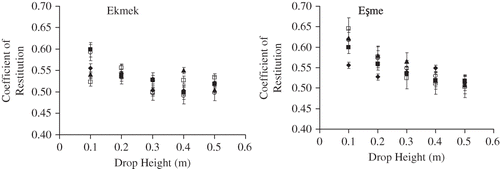
shows the absorbed energy against drop height for impacts against the five impact surface materials for two varieties. As would be expected, the absorbed energy increases with the dropping height. The absorbed energy (Eabs ) values of Ekmek variety increased linearly from 0.14 to 0.97 J (plastic), 0.13 to 0.68 J (wood), 0.11 to 0.83 J (rubber), 0.11 to 0.81 J (stainless steel), and 0.10 to 0.57 J (corrugated board), as the drop height increased from 0.1 to 0.5 m. For Eşme variety, Eabs values also increased linearly from 0.10 to 0.73 J (plastic), 0.10 to 0.83 J (wood), 0.12 to 0.81 J (rubber), 0.13 to 0.74 J (stainless steel), and 0.09 to 0.62 J (corrugated board), as the drop height increased from 0.1 to 0.5 m. Impact surface material and drop heights significantly affected absorbed energy, while varieties did not significantly affect absorbed energy (p < 0.01). The interaction of these three factors was not significant. shows the absorbed energy against bruise volume for impacts against the five impact surface materials for two varieties. The coefficient of correlation between absorbed energy and bruise volume was highly significant for each variety (R = 0.91). Similar trends have been reported by Holt and Schoorl[Citation27] for apple.
CONCLUSIONS
The selected geometric and hydrodynamic properties in water and impact parameters of two varieties of quince fruit were determined. This study showed that there were no significant differences in selected geometric and hydrodynamic properties except sphericity and coefficient of friction on wood, rubber, and stainless steel between two varieties. The impact parameters were determined by measuring the coefficient of restitution, absorbed energy, bruise area and bruise volume at different drop heights and selected impact surfaces. The smallest bruise area and volume were obtained with corrugated board. The coefficient of restitution decreased with the increase in the drop height for each variety. The strong linear correlation was found between energy absorbed and bruise volume. The changes of the bruise area and bruise volume due to drop height were found to be significantly different (p < 0.01) between corrugated board impact surface and others for Ekmek variety. For five impact surfaces, no significant changes of bruise volume were found for the Eşme variety.
REFERENCES
- Marina , F. , Escalada , P. , Morena , U. , Eliana , N.F. , Lia , N.G. and Ana , M.R. 2010 . Influence of the isolation procedure on the characteristics of fiber-rich products obtained from quince wastes . Journal of Food Engineering , 96 : 239 – 248 .
- 2. FAO. Statistical Database. 2010 http://faostat.fao.org (http://faostat.fao.org)
- Schoorl , D. and Holt , J.E. 1980 . Bruise resistance measurements in apples . Journal of Texture Studies , 11 : 389 – 394 .
- Klein , J.D. 1987 . Relationship of harvest data, storage conditions, and fruit characteristics to bruise susceptibility of apple . Journal of the American Society for Horticultural Science , 112 ( 1 ) : 113 – 118 .
- Abbott , J.A. and Lu , R. 1996 . Anisotropic mechanical properties of apples . Transactions of the American Society of Agricultural Engineers , 39 : 1451 – 1459 .
- Aydın , C. and Çarman , K. 1998 . “ Determination of bruise damage depending on impacted energy in apple to apple ” . In Proceedings of the 18th National Symposium on Mechanization in Agriculture 773 – 778 . Tekirdağ , , Turkey in Turkish
- Vursavuş , K. and Özgüven , F. 1999 . “ Determination of the some mechanical properties and susceptibility to bruising damage of apples ” . In Proceedings of the 7th International Congress on Agricultural Mechanization and Energy 570 – 575 . Adana , , Turkey
- Wang , J. 2004 . Mechanical properties of pear as a function of location and orientation . International Journal of Food Properties , 7 ( 2 ) : 155 – 164 .
- Garcia , J.L. , Ruiz-Altisent , M. and Barreiro , P. 1995 . Factors influencing mechanical properties and bruise susceptibility of apples and pears . Journal of Agricultural Engineering Research , 61 : 11 – 17 .
- Yurtlu , Y.B. and Erdoğan , D. 2005 . Effect of storage time on some mechanical properties and bruise susceptibility of pears and apples . Turkish Journal of Agriculture and Forestry , 29 : 469 – 482 .
- Wang , J. and Teng , B. 2006 . Firmness evaluation by drop impact characteristics for peach . International Journal of Food Properties , 9 ( 3 ) : 439 – 451 .
- Brusewitz , G.H. , McCollumn , T.G. and Zhang , X. 1991 . Impact bruise resistance of peaches . Transactions of the American Society of Agricultural Engineers , 34 : 962 – 965 .
- Vursavuş , K. and Özgüven , F. 2003 . Determining the strength properties of the Dixired peach variety . Turkish Journal of Agriculture and Forestry , 27 : 155 – 160 .
- Bollen , A.F. , Nguyen , H.X. and Dela Rue , B.T. 1999 . Comparison of methods for estimating the bruise volume of apples . Journal of Agricultural Engineering Research , 74 : 325 – 330 .
- Kheiralipour , K. , Tabatabaeefar , A. , Mobli , H. , Rafiee , S. , Sharifi , M. , Jafari , A. and Rajabipour , A. 2008 . Some physical and hydrodynamic properties of two varieties of apple (Malus domestica Borkh L.) . International Agrophysics , 22 : 225 – 229 .
- Akinci , I. , Ozdemir , F. , Topuz , A. , Kabas , O. and Canakci , M. 2004 . Some physical and nutritional properties of Juniperus drupacea fruits . Journal of Food Engineering , 65 : 325 – 331 .
- Mohsenin , N.N. 1986 . Physical Properties of Plant and Animal Materials , New York : Gordon and Breach Science Publishers .
- Hacıseferoğulları , H. , Gezer , İ , Özcan , M.M. and Asma , B.M. 2007 . Post harvest chemical and physical–mechanical properties of some apricot varieties cultivated in Turkey . Journal of Food Engineering , 79 : 364 – 373 .
- Kheiralipour , K. , Tabatabaeefar , A. , Mobli , H. , Mohtasebi , S.S. , Rafiee , S. , Rajabipour , A. and Jafari , A. 2010 . Terminal velocity and its relationship to physical characteristics of apple (Malus domestica Borkh L.) . International Journal of Food Properties , 13 ( 2 ) : 261 – 271 .
- Mirzaee , E. , Rafiee , S. , Keyhani , K. , Emam-Djomeh , Z. and Kheiralipour , K. 2009 . Hydro-sorting of apricots based on some physical characteristics . Research in Agricultural Engineering , 55 ( 4 ) : 159 – 164 .
- Nagurka , M. 2003 . Aerodynamic effects in a dropped ping-pong ball experiment . International Journal of Engineering Education , 19 ( 4 ) : 623 – 630 .
- Wadhwa , A. 2009 . Measuring the coefficient of restitution using a digital oscilloscope . Physics Education , 44 ( 5 ) : 517 – 521 .
- Lewis , R. , Yoxall , A. , Canty , L.A. and Reina Romo , E. 2007 . Development of engineering design tools to help reduce apple bruising . Journal of Food Engineering , 83 : 356 – 365 .
- Mirzaee , E. , Rafiee , S. , Keyhani , A. and Emam-Djom-eh , Z. 2009 . Physical properties of apricot to characterize best post harvesting options . Australian Journal of Crop Science , 3 ( 2 ) : 95 – 100 .
- Lu , F. , Ishikawa , Y. , Kitazawa , H. and Satake , T. 2010 . Measurement of impact pressure and bruising of apple fruit using pressure-sensitive film technique . Journal Food Engineering , 96 : 614 – 620 .
- Lichtensteiger , M.J. , Holmes , R.G. , Hamdy , M.Y. and Blaisdell , J.L. 1988 . Impact parameters of spherical viscoelastic objects and tomatoes . Transactions of the American Society of Agricultural Engineers , 31 ( 2 ) : 595 – 6002 .
- Holt , J.E. and Schoorl , D. 1977 . Bruising and energy dissipation in apples . Journal of Texture Studies , 7 ( 4 ) : 421 – 432 .
